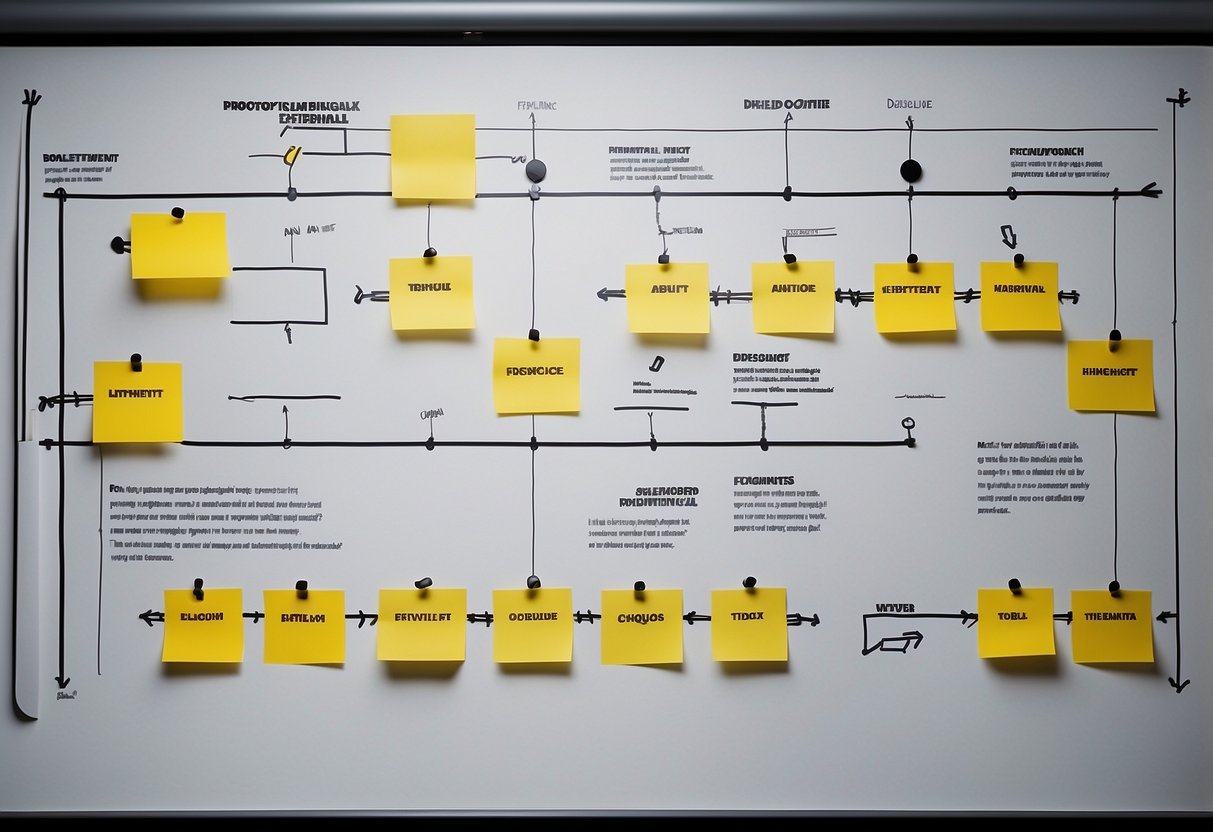Project Planning and Scope
When planning to build a website, it’s essential to clearly define your needs, consider your budget, set realistic timeline expectations, and outline the functionality and features required. Each aspect contributes to the successful execution of your project.
Understanding Your Needs
To start, identify your target audience. Knowing who will use your website helps tailor the design and content to meet their needs. Are you creating an e-commerce site, a blog, or a portfolio? Each type has different requirements.
Next, consider the goals of your website. Are you looking to generate leads, sell products, or provide information? Defining these goals will guide the overall structure and design.
Lastly, map out a basic site structure. Identify the main pages and the kind of content each page will feature.
Budget Considerations
Setting a budget is crucial. The budget influences the quality and scope of your website. Developers, designers, and content creators come with varying price tags depending on their expertise and location.
Consider the cost of hosting and domain registration. Ongoing maintenance and updates should also be included in the budget.
Evaluate if there’s room for flexibility. Sometimes unexpected expenses arise during development, so having a contingency fund may be beneficial.
Timeline Expectations
You need to establish a realistic timeline. Building a website typically takes anywhere from one to six months, depending on complexity and resources.
Break down the schedule into key phases: planning, design, development, and testing. Each phase should have specific start and end dates.
Set milestones to track progress. Milestones help ensure that the project stays on schedule and any potential delays are noticed early.
Defining Functionality and Features
List the core functionalities your site needs. This might include e-commerce capabilities, contact forms, or multimedia integration. Each function plays a role in how the website operates and serves users.
Identify essential features versus optional ones. Deciding which features are critical can help manage both budget and timeline constraints.
Consider scalability. The website should be able to grow as your business or project expands, so plan functionalities with future needs in mind.
When you have a clear project plan and scope, successful website development becomes more attainable.
Choosing the Right Technology
Selecting the right technology to build your website is a crucial step. You need to decide between website builders, content management systems (CMS), and appropriate domain and hosting services. Each choice has its own benefits and challenges.
Selecting a Website Builder
Website builders like Wix, Squarespace, and Weebly are popular choices for many users. They offer drag-and-drop interfaces, making the design process simple, even for those with little technical knowledge. However, website builders like this often are extremely limited and do not scale with your business very well. It’s important to educate yourself on these options before diving right in. Typically, WordPress is on average the best choice for most websites.
Understanding CMS Options
Content Management Systems (CMS) offer more flexibility than website builders and are ideal for larger or more complex sites. Popular CMS options include WordPress, Joomla, and Drupal.
WordPress is a versatile platform with thousands of themes and plugins. It powers a significant portion of the internet due to its customization options and scalability. Joomla and Drupal also offer robust options but are more complex and may require technical knowledge.
Using a CMS like WordPress can take longer to set up than a website builder, often ranging from several days to weeks, depending on your needs and customization levels.
Domain and Hosting Selection
Choosing the right domain name and hosting service is essential for your website’s success. A domain name should be easy to remember and reflective of your brand. Registering a domain can be done through various providers like GoDaddy or Namecheap.
For hosting, you need to consider factors like uptime, customer support, and scalability. Options range from shared hosting (ideal for small sites) to VPS and dedicated hosting (better for larger sites with higher traffic).
Services like Bluehost, HostGator, and SiteGround offer various packages to suit different needs. The hosting environment you choose will impact your site’s performance, speed, and security. Therefore, selecting the right domain and hosting service should not be overlooked.
Designing Your Website
When designing your website, you will focus on crafting an engaging user experience, creating detailed mockups, choosing the right themes and templates, and incorporating your branding elements to ensure consistency and professionalism.
Crafting the User Experience
The user experience (UX) is crucial. Start by identifying your target audience and their needs. Think about how users will navigate your site. A clear flow and intuitive design make it easier for visitors to find what they’re looking for.
Use simple menus, clear headings, and logical layouts. Avoid cluttering pages with too much information. Keep your colour scheme consistent and easy on the eyes. Test your design on multiple devices to ensure it looks good everywhere. A mobile-friendly design is essential in today’s world.
Creating Mockups and Wireframes
Before you dive into full-fledged design, create mockups and wireframes. These are basic sketches or digital prototypes of your website’s layout. Wireframes focus on structure without colours and images, while mockups include more detail.
Tools like Adobe XD, Sketch, or Figma can help. These prototypes allow you to experiment with layouts and design elements without much commitment. By doing this, you can see what works and what doesn’t before investing significant time in development.
Involving stakeholders in this process can also provide valuable feedback early on, making adjustments easier.
Choosing Themes and Templates
Choosing the right theme or template sets the tone for your website. Many platforms like WordPress or Wix offer pre-designed templates that you can customize. Pick one that aligns with your branding and business goals.
Look for templates that are responsive and mobile-friendly. Make sure they are easy to navigate and don’t overwhelm your visitors with too many elements. Consider the layout flexibility and ease of customization.
Some templates come with built-in features like SEO tools and analytics, which can be beneficial.
Incorporating Branding Elements
Your website should reflect your brand’s identity. This includes your logo, colour scheme, fonts, and any other visual elements that represent your brand. Consistency is key to building recognition and trust.
Place your logo prominently, usually in the header and footer. Use your brand colours strategically to emphasize important content without overwhelming the user. Choose fonts that are easy to read and consistent with your brand’s style.
Make sure images and other media are high quality and relevant to your content. Branding should also extend to your tone of voice and the way you communicate through text.
Developing Content Strategy
When building a website, a strong content strategy is crucial. This section focuses on creating engaging content, optimizing for SEO, and adding multimedia to enhance user experience and search engine rankings.
Creating Engaging Content
Creating engaging content involves knowing your audience and delivering what they need. Start by researching your target audience to understand their interests and pain points. Use this information to craft content that speaks directly to them.
Use a variety of content types such as blog posts, articles, and videos. This keeps your website dynamic and interesting.
Storytelling is an effective tool. A compelling story can make your brand more relatable and memorable. Ensure content is well-organized with clear headings, short paragraphs, and bullet points to improve readability.
Optimizing for SEO
Search Engine Optimization (SEO) is essential for making your content discoverable. Start with keyword research to find relevant terms your audience searches for. Tools like Google Keyword Planner can help identify these keywords.
Include keywords naturally in your content, headings, and meta descriptions. Avoid keyword stuffing, as this can hurt your rankings. Internal linking within your website helps search engines understand your site structure and improves navigation.
Regularly updating your content signals to search engines that your site is active, which can improve rankings. Utilize SEO best practices in each piece of content to draw traffic and keep users engaged.
Adding Multimedia
Adding multimedia elements like images and videos can make your content more engaging. Images break up text and make content visually appealing. Use high-quality, relevant images, and optimize them by adding descriptive alt text for better SEO.
Video content can explain complex ideas more effectively than text. Embed videos directly into your blog posts or pages to provide value to your audience. Keep videos short and to the point to maintain viewer interest.
Infographics are another powerful tool for visual storytelling. They can summarize data or processes in a visually engaging way. Ensure all multimedia elements are optimized for fast loading times to maintain a good user experience.
By focusing on these areas, you can develop a robust content strategy that attracts and retains your audience.
Building the Website
Creating your website involves setting up its structure, adding and customizing features, and thorough testing. Each step requires attention to ensure your site is functional, user-friendly, and free of bugs.
Setting Up the Structure
Start by deciding on the basic layout of your site. This includes selecting a website builder or deciding to code from scratch. Tools like WordPress, Wix, or Squarespace can speed up the process. These tools often have pre-built templates that make it easier to design without needing advanced coding skills.
Next, organize your site’s content. Create a sitemap that outlines your main pages, like Home, About, Services, and Contact. A clear structure helps visitors navigate your site easily. You should also ensure responsive design so it looks good on various devices.
Pick a reliable hosting service to get your site online. Consider factors like uptime, speed, and customer support. Register your domain name, which is your website’s address on the internet. This setup phase might take anywhere from a few days to a couple of weeks, depending on your level of expertise and the complexity of the site.
Customizing and Adding Features
Once your structure is in place, start customizing your site to fit your brand. Choose a design theme that aligns with your brand’s image. You can further personalize it by adjusting colours, fonts, and images to ensure consistency and visual appeal.
Add important features that enhance user experience. This includes contact forms, social media integration, and interactive elements like sliders or galleries. Use plugins or extensions to add functionality without extensive coding. For example, SEO plugins help optimize your site for search engines, while security plugins keep your site safe from threats.
Make sure to consider accessibility features to make your site usable for everyone, including those with disabilities. This can include things like alt text for images and keyboard navigation options. Customization can take a few hours to several weeks based on how detailed you want your site to be.
Testing and Troubleshooting
Testing your website before it goes live is crucial. Start with usability testing to ensure that visitors can navigate easily. Test forms to ensure submissions go through and links to verify they direct to the correct pages.
Check for bugs by previewing your site on different devices and browsers. Look for broken links, slow-loading pages, and formatting issues. Use tools like Google’s Mobile-Friendly Test to see how your site performs on smartphones and tablets.
It’s also important to test the site’s functionality. For instance, if you have an e-commerce site, make sure the checkout process works smoothly. Monitor your site’s performance using tools like Google Analytics for insights into visitor behaviour and site speed.
If you find any issues, troubleshoot them immediately. This may involve debugging code, updating plugins, or adjusting settings. Addressing these problems can take anywhere from a few days to a couple of weeks, depending on their complexity.
Launch and Post-Launch Activities
Building a website is just the beginning. The launch and post-launch phases are crucial for ensuring your site runs smoothly and attracts visitors. This includes going live, continuous monitoring, making necessary updates, and marketing to drive traffic.
Going Live with Your Website
When your website is ready to launch, test every feature to ensure it works properly. Check links, forms, and interactive elements. Ensure your site is user-friendly and loads quickly. Store passwords and credentials securely. Reset these after launch to maintain security as recommended by HubSpot.
Set a launch date and follow a checklist to ensure all steps are completed. Promoting your website beforehand can create buzz and attract an initial audience. Use email campaigns and social media to inform your followers about the upcoming launch.
Monitoring and Updates
Once live, consistent monitoring is essential. Use tools to track website performance and user behaviour. Google Analytics can help you understand how visitors interact with your site. Identify and fix any issues quickly to maintain a smooth user experience.
Regular updates are necessary to keep your website secure and functional. Update plugins, themes, and software to avoid security vulnerabilities. Set a schedule for these updates and ensure backups are created beforehand. Customer feedback is valuable for identifying areas of improvement.
Driving Traffic and Marketing
To attract visitors, implement a solid marketing strategy. Start with search engine optimization (SEO) to improve your site’s visibility on search engines. Use relevant keywords and quality content to rank higher in search results.
Leveraging social media platforms is also effective. Share updates, blog posts, and promotions to engage your audience. Email marketing can further enhance your reach. Use targeted campaigns to inform subscribers of new content, offers, or updates. Lastly, consider using pay-per-click (PPC) advertising for immediate traffic boosts.
Maintenance and Growth
Keeping a website functional and updated is crucial for its success. This involves regular updates, ensuring security, and actively listening to user feedback.
Regular Website Updates
Regular updates are essential for maintaining your website. New content should be added to keep users engaged and improve your search engine ranking. Updating your site could include blog posts, news, or product information.
Software updates are also important. Keeping your content management system (CMS) and plugins updated ensures they run smoothly and minimizes compatibility issues. Additionally, outdated software can expose your site to vulnerabilities.
Bug fixes are another aspect. These can be identified through continuous monitoring. Fixing broken links, correcting errors, and making small tweaks improve user experience and site performance.
Security Considerations
Security is a top priority for any website. There are multiple steps you can take to protect your site. Installing security plugins helps detect and prevent threats. These tools monitor your site for malware and other malicious activities.
Regular backups are crucial. They help restore your site in case of an attack or accidental data loss. Setting up automated backups ensures that data is consistently saved.
SSL certificates are vital for encrypting data transferred between your site and users. This not only secures information but also builds trust with your audience. Search engines like Google also favour secure websites in their rankings.
Monitoring for intrusions should be continuous. This can be done using various security monitoring tools which alert you to any suspicious activities on your site.
Listening to User Feedback
User feedback offers valuable insights into the performance and usability of your website. Surveys and feedback forms can be used to gather direct opinions from your users. You can learn what they like, dislike, and what issues they encounter.
Reviewing analytics data helps understand user behaviour on your site. Identifying patterns in page views, bounce rates, and session durations can reveal strengths and weaknesses.
Acting on feedback is key. Addressing common concerns or suggestions can improve user satisfaction and retention. This could mean updating content, redesigning certain elements, or fixing identified problems.
Engaging with users through social media and comments sections is also beneficial. Responding to their feedback publicly shows that you value their input and are committed to improving their experience.
Cost Analysis
When looking into building a website, understanding the cost involved is crucial. Here’s a breakdown of potential expenses you might encounter:
Domain and Hosting
- Domain Name: $10 – $30 per year
- Web Hosting: $2.99 – $299 per month
These costs vary widely. Basic domains are cheaper, custom ones cost more. Hosting also ranges from budget-friendly options to premium plans.
Development and Design
- DIY Website Builders: $2.99 – $299 per month
- WordPress: ~$1,000+ upfront, plus additional ongoing costs
- Hiring Freelancers: $1,000 – $5,000+
- Professional Agencies: $1,000 – $100,000+
Choosing between a DIY builder, hiring a freelancer, or working with an agency will impact your budget significantly. Freelancers may offer a balance between cost and expertise. Agencies provide comprehensive services but come at a higher cost.
Additional Expenses
- Premium Themes: $50
- Plugins and Extensions: $47 – $200
- Ecommerce Functionality: Additional cost depending on complexity
Extra features like themes and plugins can enhance your website but also add to the overall budget. If you need an ecommerce site, expect higher costs for secure payment systems and other custom needs.
Budgeting carefully for these expenses ensures you get the best value for your investment and a website that meets your needs.
Choosing a Development Approach
When building a website, deciding how you will develop it is crucial. There are several paths you can take: doing it yourself, hiring a professional agency, using pre-made templates, or leveraging drag-and-drop builders. Each has its own benefits and drawbacks.
DIY vs. Professional Agency
Choosing between DIY and hiring a professional agency depends on your expertise, budget, and goals. Doing it yourself can save money and offers complete control over the project. It is ideal for those with time and some technical knowledge.
Hiring a professional agency, on the other hand, ensures a polished, high-quality result. Agencies bring experience, access to advanced tools, and a team of experts. This approach is suitable if you have a larger budget and need a complex, custom website.
DIY Advantages:
- Cost-effective
- Full control
Agency Advantages:
- High-quality results
- Professional expertise
Pros and Cons of Pre-Made Templates
Pre-made templates can speed up website development and reduce costs. They are available on many platforms and often come with customizable features. These templates are excellent for beginners and those on a tight budget.
Pros:
- Affordable
- Time-saving
- User-friendly
However, pre-made templates also have limitations. They offer less flexibility and uniqueness. You might run into design constraints and find it difficult to stand out.
Cons:
- Limited customization
- Less unique designs
Leveraging Drag-and-Drop Builders
Drag-and-drop builders like Wix, Squarespace, and Shopify offer a middle ground. They allow users to create websites easily without coding. These tools are suitable for small businesses, freelancers, and personal sites.
Key Features:
- No coding required
- User-friendly interface
- Quick setup
They come with various design templates and allow adjustments through a simple interface. This method combines ease of use with decent customization options. However, advanced users might find them limiting.
Pros:
- Easy to use
- Fast development
Cons:
- Limited advanced customization
- Dependency on the platform’s SaaS model
Choosing the right development approach depends on your specific needs, technical skills, and budget. Each method has distinct benefits and drawbacks, so evaluate carefully before making a decision.
Evolving Technologies
Technology is changing how websites are designed and built. The rise of AI tools in web design and the need for responsive design across different devices are transforming the process significantly.
Emergence of AI Tools in Web Design
AI tools are now playing a major role in web design. These tools can automate many tasks, such as creating templates, generating content, and optimizing layouts. For example, platforms like Wix use AI to help you design a personalized website by asking a few questions about your preferences.
This saves you significant time and effort. SaaS platforms are also integrating AI to improve their offerings. By using AI, you can quickly adapt to market trends and user preferences. This technology helps you build websites that are not only visually appealing but also highly functional.
In addition, AI tools can assist in search engine optimization (SEO) by analysing data and suggesting improvements. This ensures that your website gets better visibility and reaches your target audience effectively.
Responsive Design for Various Devices
With a variety of devices available, from smartphones to tablets and desktops, your website needs to be responsive. Responsive design ensures that your site looks good and functions well on all devices. This is crucial because users expect a seamless experience regardless of the device they are using.
For example, responsive design uses flexible grids and layouts that adjust according to the screen size. Images and text will resize and rearrange to fit the device, making it easier for users to navigate. Implementing responsive design helps your website perform better in search engines, as search engines favour mobile-friendly sites.
Developing a responsive website may require more planning and testing, but the benefits are significant. You will provide a consistent and user-friendly experience that keeps visitors engaged and improves your site’s performance.
Frequently Asked Questions
Building a website involves various stages, and the time required can depend on the type of site and the skills of the developer. Here are some of the most frequently asked questions about website development timelines.
How many hours are typically required to build a website?
The time needed can vary widely. A simple site may take between 20 to 40 hours. More complex websites with advanced features can take upwards of 100 to 200 hours, depending on specific requirements.
What is the average development time for a custom HTML website?
Creating a custom HTML site often takes between 2 to 6 weeks. This includes design, coding, and testing. For larger projects, the timeline may extend to several months, especially if there are multiple revisions.
What are the time considerations for launching a new WordPress site?
A basic WordPress site with pre-made templates and plugins can be set up in 1 to 2 weeks. Custom themes and plugins can extend this timeline to 4 to 6 weeks, depending on the complexity and customization needs.
How long does creating and populating content for a site normally take?
Content creation can take 4 to 6 weeks. This includes writing, editing, and formatting text, as well as creating images and videos. The exact time depends on the amount of content and the efficiency of the content creators.
What is the typical timeframe for constructing an e-commerce site on Shopify?
Building an e-commerce site on Shopify usually requires 2 to 4 weeks for a basic store. For a store with extensive product catalogues and custom features, the timeframe can extend to 8 to 12 weeks, or more.
Why might website development projects experience extended timelines?
Delays often occur due to changes in project scope, unforeseen technical issues, or content not being ready on time. Clear communication and realistic planning can help mitigate such delays. Additionally, the complexity and size of the website play a significant role in the timeline.




